Critical Analysis on the Future of Unions: Challenges & Impact
VerifiedAdded on 2023/04/24
|13
|3682
|71
Essay
AI Summary
This essay provides a critical analysis of the future of unions, exploring their historical context, impact on employees and companies, and the interests they seek to maintain. It delves into the role of federal regulations and governmental entities, comparing local versus national unions and their impact on global unionization. The analysis further examines the variances between for-profit and not-for-profit unionization, the influence on employee wage and non-wage considerations, and the impact of wellness initiatives and employee safety. Finally, it addresses the challenges multinational companies face in a future global business setting. Desklib offers a platform to explore similar solved assignments and past papers for students.
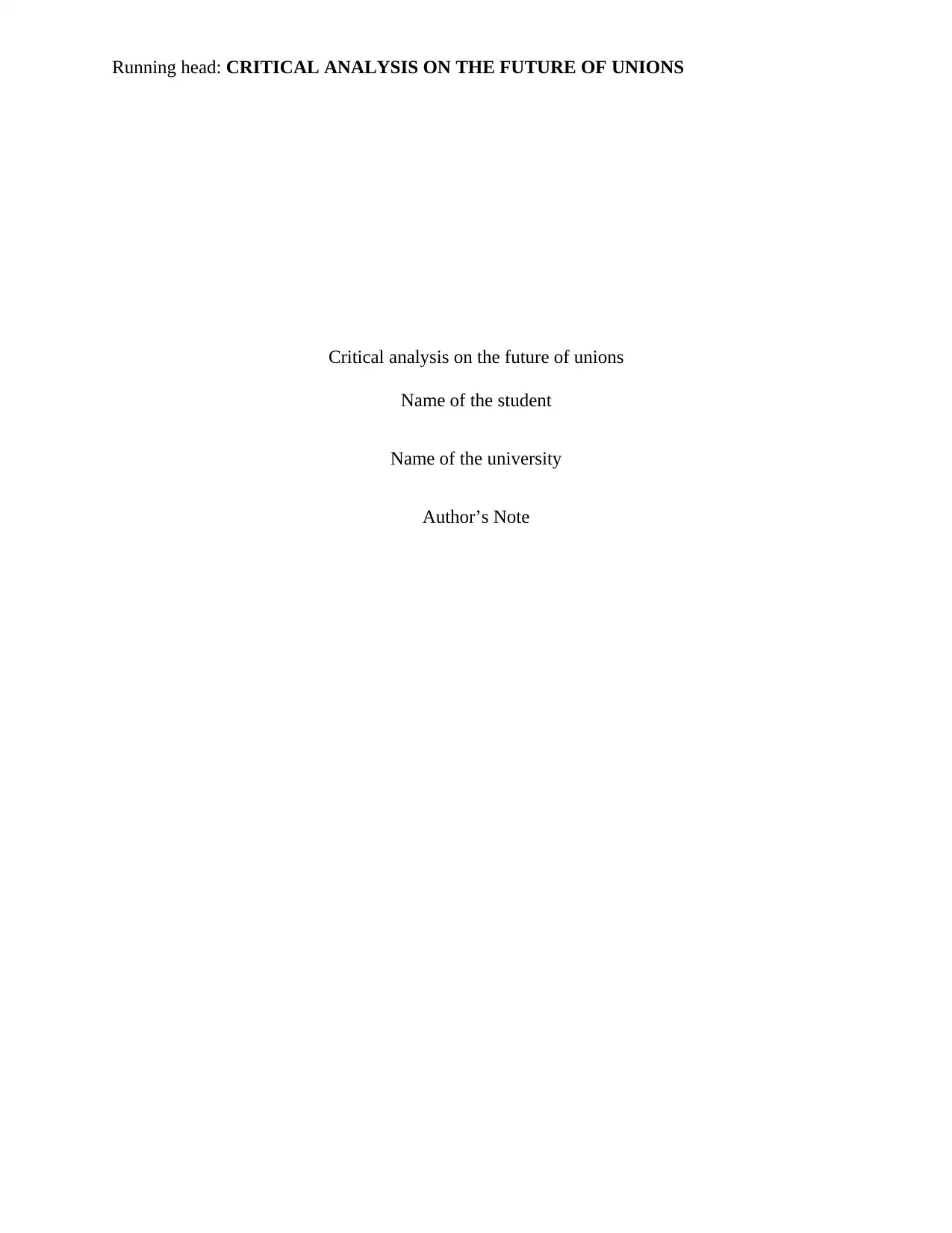
Running head: CRITICAL ANALYSIS ON THE FUTURE OF UNIONS
Critical analysis on the future of unions
Name of the student
Name of the university
Author’s Note
Critical analysis on the future of unions
Name of the student
Name of the university
Author’s Note
Secure Best Marks with AI Grader
Need help grading? Try our AI Grader for instant feedback on your assignments.
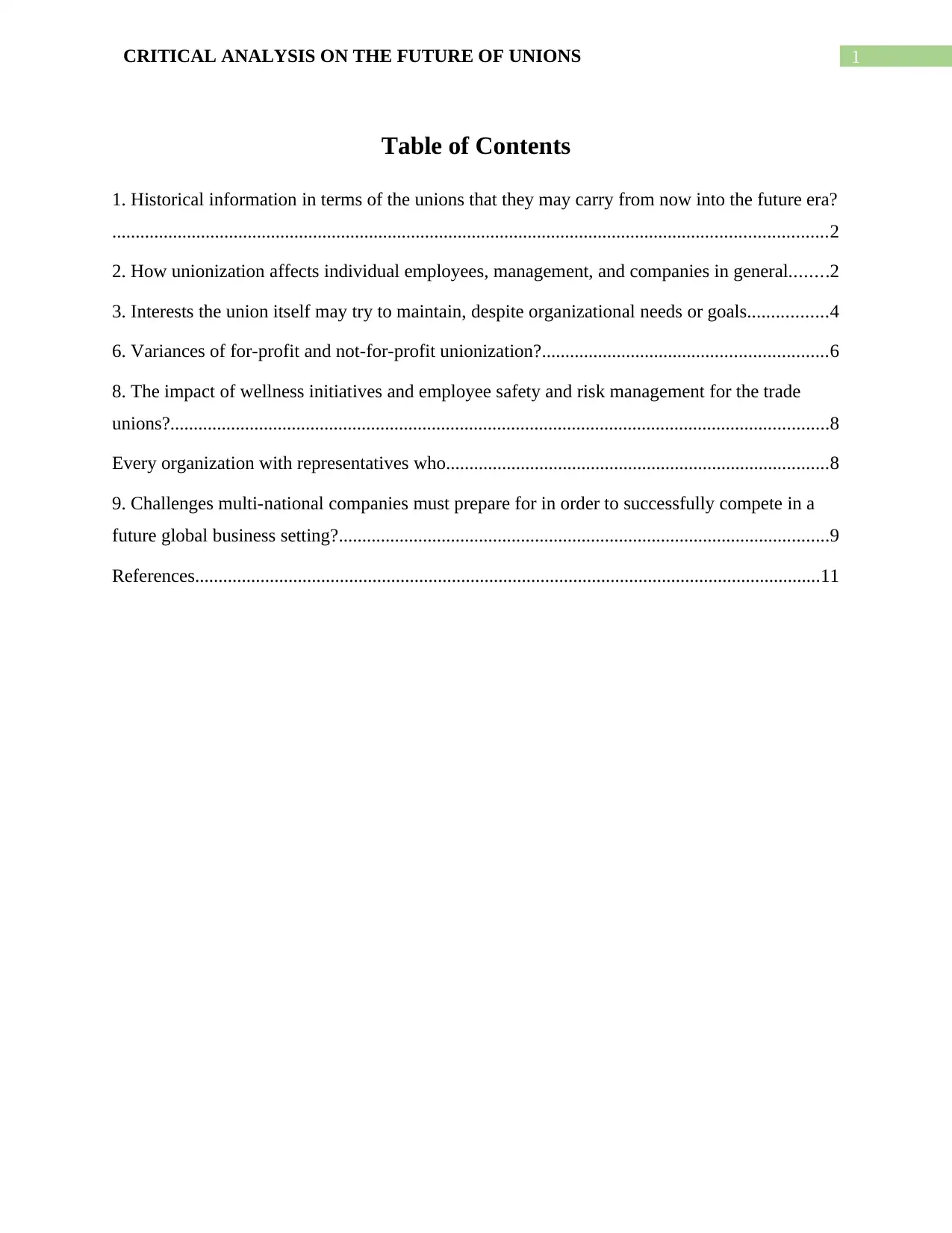
1CRITICAL ANALYSIS ON THE FUTURE OF UNIONS
Table of Contents
1. Historical information in terms of the unions that they may carry from now into the future era?
.........................................................................................................................................................2
2. How unionization affects individual employees, management, and companies in general........2
3. Interests the union itself may try to maintain, despite organizational needs or goals.................4
6. Variances of for-profit and not-for-profit unionization?.............................................................6
8. The impact of wellness initiatives and employee safety and risk management for the trade
unions?.............................................................................................................................................8
Every organization with representatives who..................................................................................8
9. Challenges multi-national companies must prepare for in order to successfully compete in a
future global business setting?.........................................................................................................9
References......................................................................................................................................11
Table of Contents
1. Historical information in terms of the unions that they may carry from now into the future era?
.........................................................................................................................................................2
2. How unionization affects individual employees, management, and companies in general........2
3. Interests the union itself may try to maintain, despite organizational needs or goals.................4
6. Variances of for-profit and not-for-profit unionization?.............................................................6
8. The impact of wellness initiatives and employee safety and risk management for the trade
unions?.............................................................................................................................................8
Every organization with representatives who..................................................................................8
9. Challenges multi-national companies must prepare for in order to successfully compete in a
future global business setting?.........................................................................................................9
References......................................................................................................................................11
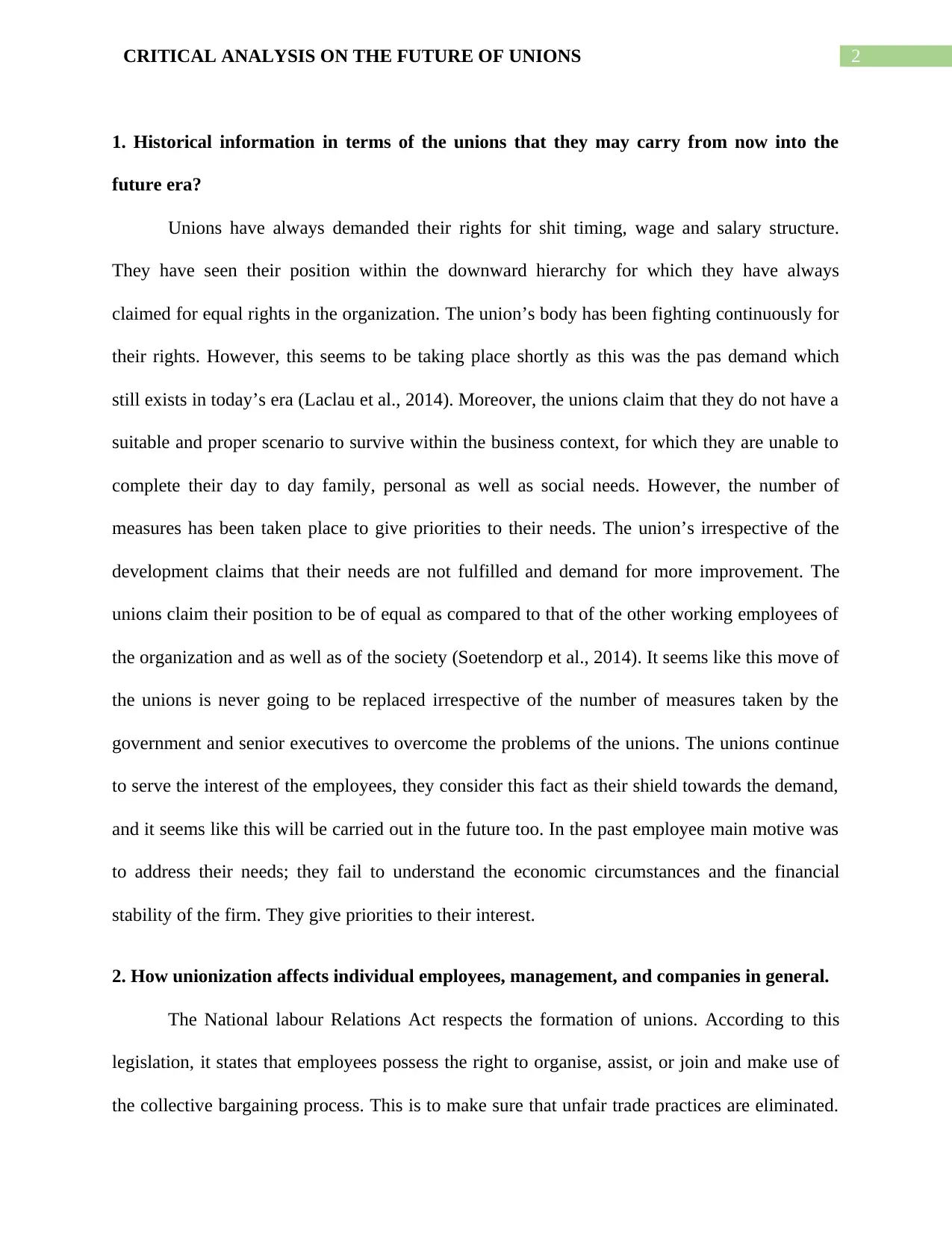
2CRITICAL ANALYSIS ON THE FUTURE OF UNIONS
1. Historical information in terms of the unions that they may carry from now into the
future era?
Unions have always demanded their rights for shit timing, wage and salary structure.
They have seen their position within the downward hierarchy for which they have always
claimed for equal rights in the organization. The union’s body has been fighting continuously for
their rights. However, this seems to be taking place shortly as this was the pas demand which
still exists in today’s era (Laclau et al., 2014). Moreover, the unions claim that they do not have a
suitable and proper scenario to survive within the business context, for which they are unable to
complete their day to day family, personal as well as social needs. However, the number of
measures has been taken place to give priorities to their needs. The union’s irrespective of the
development claims that their needs are not fulfilled and demand for more improvement. The
unions claim their position to be of equal as compared to that of the other working employees of
the organization and as well as of the society (Soetendorp et al., 2014). It seems like this move of
the unions is never going to be replaced irrespective of the number of measures taken by the
government and senior executives to overcome the problems of the unions. The unions continue
to serve the interest of the employees, they consider this fact as their shield towards the demand,
and it seems like this will be carried out in the future too. In the past employee main motive was
to address their needs; they fail to understand the economic circumstances and the financial
stability of the firm. They give priorities to their interest.
2. How unionization affects individual employees, management, and companies in general.
The National labour Relations Act respects the formation of unions. According to this
legislation, it states that employees possess the right to organise, assist, or join and make use of
the collective bargaining process. This is to make sure that unfair trade practices are eliminated.
1. Historical information in terms of the unions that they may carry from now into the
future era?
Unions have always demanded their rights for shit timing, wage and salary structure.
They have seen their position within the downward hierarchy for which they have always
claimed for equal rights in the organization. The union’s body has been fighting continuously for
their rights. However, this seems to be taking place shortly as this was the pas demand which
still exists in today’s era (Laclau et al., 2014). Moreover, the unions claim that they do not have a
suitable and proper scenario to survive within the business context, for which they are unable to
complete their day to day family, personal as well as social needs. However, the number of
measures has been taken place to give priorities to their needs. The union’s irrespective of the
development claims that their needs are not fulfilled and demand for more improvement. The
unions claim their position to be of equal as compared to that of the other working employees of
the organization and as well as of the society (Soetendorp et al., 2014). It seems like this move of
the unions is never going to be replaced irrespective of the number of measures taken by the
government and senior executives to overcome the problems of the unions. The unions continue
to serve the interest of the employees, they consider this fact as their shield towards the demand,
and it seems like this will be carried out in the future too. In the past employee main motive was
to address their needs; they fail to understand the economic circumstances and the financial
stability of the firm. They give priorities to their interest.
2. How unionization affects individual employees, management, and companies in general.
The National labour Relations Act respects the formation of unions. According to this
legislation, it states that employees possess the right to organise, assist, or join and make use of
the collective bargaining process. This is to make sure that unfair trade practices are eliminated.
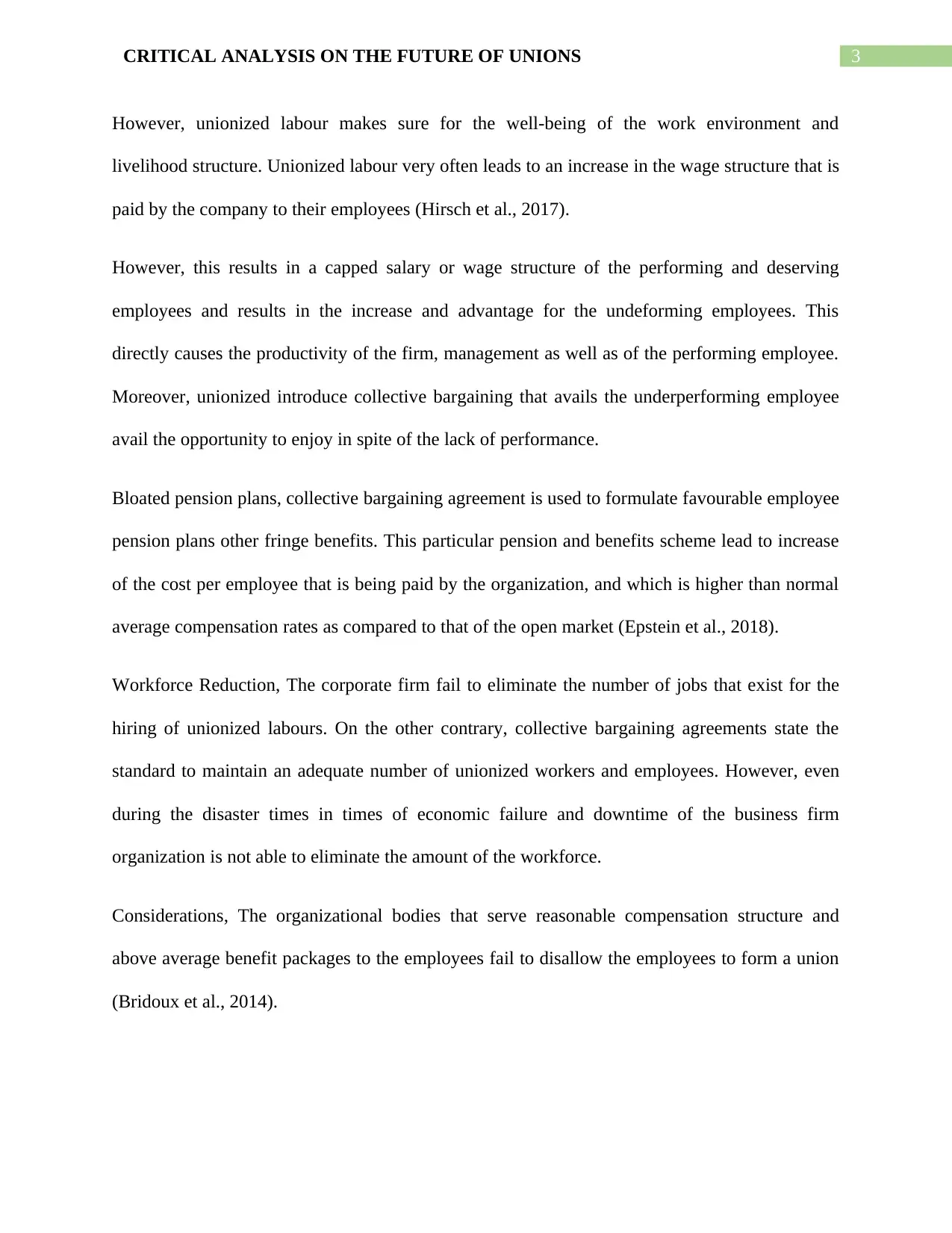
3CRITICAL ANALYSIS ON THE FUTURE OF UNIONS
However, unionized labour makes sure for the well-being of the work environment and
livelihood structure. Unionized labour very often leads to an increase in the wage structure that is
paid by the company to their employees (Hirsch et al., 2017).
However, this results in a capped salary or wage structure of the performing and deserving
employees and results in the increase and advantage for the undeforming employees. This
directly causes the productivity of the firm, management as well as of the performing employee.
Moreover, unionized introduce collective bargaining that avails the underperforming employee
avail the opportunity to enjoy in spite of the lack of performance.
Bloated pension plans, collective bargaining agreement is used to formulate favourable employee
pension plans other fringe benefits. This particular pension and benefits scheme lead to increase
of the cost per employee that is being paid by the organization, and which is higher than normal
average compensation rates as compared to that of the open market (Epstein et al., 2018).
Workforce Reduction, The corporate firm fail to eliminate the number of jobs that exist for the
hiring of unionized labours. On the other contrary, collective bargaining agreements state the
standard to maintain an adequate number of unionized workers and employees. However, even
during the disaster times in times of economic failure and downtime of the business firm
organization is not able to eliminate the amount of the workforce.
Considerations, The organizational bodies that serve reasonable compensation structure and
above average benefit packages to the employees fail to disallow the employees to form a union
(Bridoux et al., 2014).
However, unionized labour makes sure for the well-being of the work environment and
livelihood structure. Unionized labour very often leads to an increase in the wage structure that is
paid by the company to their employees (Hirsch et al., 2017).
However, this results in a capped salary or wage structure of the performing and deserving
employees and results in the increase and advantage for the undeforming employees. This
directly causes the productivity of the firm, management as well as of the performing employee.
Moreover, unionized introduce collective bargaining that avails the underperforming employee
avail the opportunity to enjoy in spite of the lack of performance.
Bloated pension plans, collective bargaining agreement is used to formulate favourable employee
pension plans other fringe benefits. This particular pension and benefits scheme lead to increase
of the cost per employee that is being paid by the organization, and which is higher than normal
average compensation rates as compared to that of the open market (Epstein et al., 2018).
Workforce Reduction, The corporate firm fail to eliminate the number of jobs that exist for the
hiring of unionized labours. On the other contrary, collective bargaining agreements state the
standard to maintain an adequate number of unionized workers and employees. However, even
during the disaster times in times of economic failure and downtime of the business firm
organization is not able to eliminate the amount of the workforce.
Considerations, The organizational bodies that serve reasonable compensation structure and
above average benefit packages to the employees fail to disallow the employees to form a union
(Bridoux et al., 2014).
Secure Best Marks with AI Grader
Need help grading? Try our AI Grader for instant feedback on your assignments.
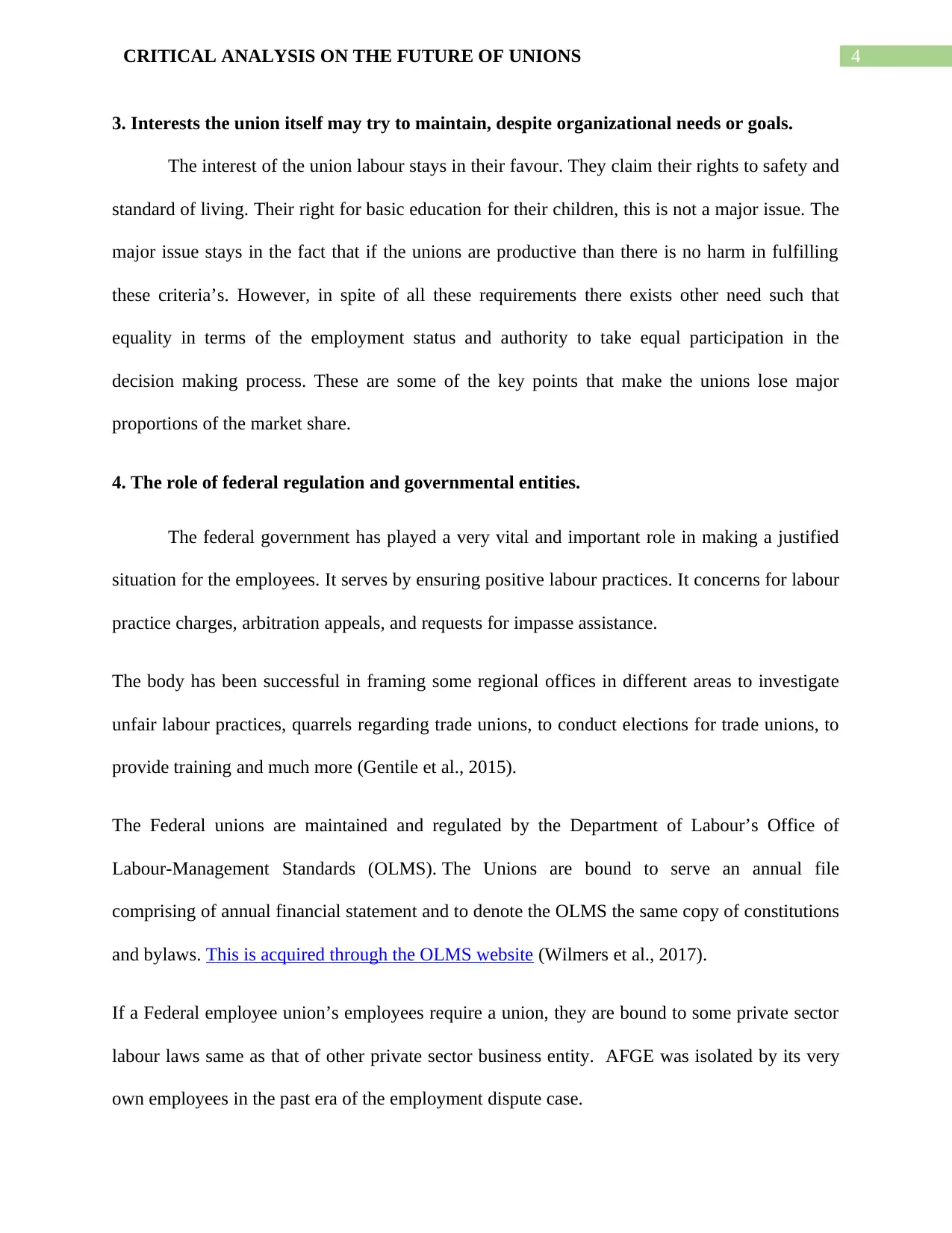
4CRITICAL ANALYSIS ON THE FUTURE OF UNIONS
3. Interests the union itself may try to maintain, despite organizational needs or goals.
The interest of the union labour stays in their favour. They claim their rights to safety and
standard of living. Their right for basic education for their children, this is not a major issue. The
major issue stays in the fact that if the unions are productive than there is no harm in fulfilling
these criteria’s. However, in spite of all these requirements there exists other need such that
equality in terms of the employment status and authority to take equal participation in the
decision making process. These are some of the key points that make the unions lose major
proportions of the market share.
4. The role of federal regulation and governmental entities.
The federal government has played a very vital and important role in making a justified
situation for the employees. It serves by ensuring positive labour practices. It concerns for labour
practice charges, arbitration appeals, and requests for impasse assistance.
The body has been successful in framing some regional offices in different areas to investigate
unfair labour practices, quarrels regarding trade unions, to conduct elections for trade unions, to
provide training and much more (Gentile et al., 2015).
The Federal unions are maintained and regulated by the Department of Labour’s Office of
Labour-Management Standards (OLMS). The Unions are bound to serve an annual file
comprising of annual financial statement and to denote the OLMS the same copy of constitutions
and bylaws. This is acquired through the OLMS website (Wilmers et al., 2017).
If a Federal employee union’s employees require a union, they are bound to some private sector
labour laws same as that of other private sector business entity. AFGE was isolated by its very
own employees in the past era of the employment dispute case.
3. Interests the union itself may try to maintain, despite organizational needs or goals.
The interest of the union labour stays in their favour. They claim their rights to safety and
standard of living. Their right for basic education for their children, this is not a major issue. The
major issue stays in the fact that if the unions are productive than there is no harm in fulfilling
these criteria’s. However, in spite of all these requirements there exists other need such that
equality in terms of the employment status and authority to take equal participation in the
decision making process. These are some of the key points that make the unions lose major
proportions of the market share.
4. The role of federal regulation and governmental entities.
The federal government has played a very vital and important role in making a justified
situation for the employees. It serves by ensuring positive labour practices. It concerns for labour
practice charges, arbitration appeals, and requests for impasse assistance.
The body has been successful in framing some regional offices in different areas to investigate
unfair labour practices, quarrels regarding trade unions, to conduct elections for trade unions, to
provide training and much more (Gentile et al., 2015).
The Federal unions are maintained and regulated by the Department of Labour’s Office of
Labour-Management Standards (OLMS). The Unions are bound to serve an annual file
comprising of annual financial statement and to denote the OLMS the same copy of constitutions
and bylaws. This is acquired through the OLMS website (Wilmers et al., 2017).
If a Federal employee union’s employees require a union, they are bound to some private sector
labour laws same as that of other private sector business entity. AFGE was isolated by its very
own employees in the past era of the employment dispute case.
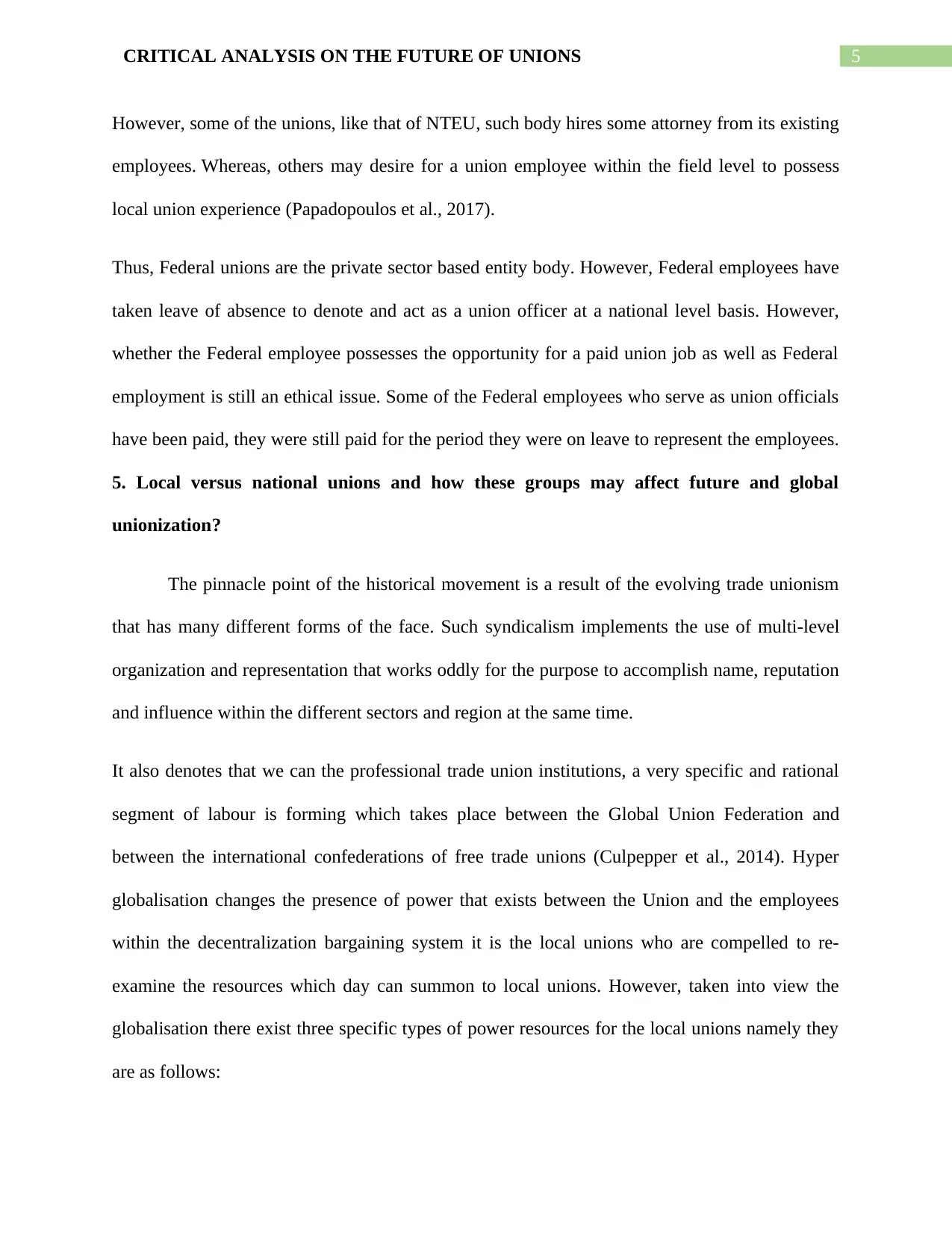
5CRITICAL ANALYSIS ON THE FUTURE OF UNIONS
However, some of the unions, like that of NTEU, such body hires some attorney from its existing
employees. Whereas, others may desire for a union employee within the field level to possess
local union experience (Papadopoulos et al., 2017).
Thus, Federal unions are the private sector based entity body. However, Federal employees have
taken leave of absence to denote and act as a union officer at a national level basis. However,
whether the Federal employee possesses the opportunity for a paid union job as well as Federal
employment is still an ethical issue. Some of the Federal employees who serve as union officials
have been paid, they were still paid for the period they were on leave to represent the employees.
5. Local versus national unions and how these groups may affect future and global
unionization?
The pinnacle point of the historical movement is a result of the evolving trade unionism
that has many different forms of the face. Such syndicalism implements the use of multi-level
organization and representation that works oddly for the purpose to accomplish name, reputation
and influence within the different sectors and region at the same time.
It also denotes that we can the professional trade union institutions, a very specific and rational
segment of labour is forming which takes place between the Global Union Federation and
between the international confederations of free trade unions (Culpepper et al., 2014). Hyper
globalisation changes the presence of power that exists between the Union and the employees
within the decentralization bargaining system it is the local unions who are compelled to re-
examine the resources which day can summon to local unions. However, taken into view the
globalisation there exist three specific types of power resources for the local unions namely they
are as follows:
However, some of the unions, like that of NTEU, such body hires some attorney from its existing
employees. Whereas, others may desire for a union employee within the field level to possess
local union experience (Papadopoulos et al., 2017).
Thus, Federal unions are the private sector based entity body. However, Federal employees have
taken leave of absence to denote and act as a union officer at a national level basis. However,
whether the Federal employee possesses the opportunity for a paid union job as well as Federal
employment is still an ethical issue. Some of the Federal employees who serve as union officials
have been paid, they were still paid for the period they were on leave to represent the employees.
5. Local versus national unions and how these groups may affect future and global
unionization?
The pinnacle point of the historical movement is a result of the evolving trade unionism
that has many different forms of the face. Such syndicalism implements the use of multi-level
organization and representation that works oddly for the purpose to accomplish name, reputation
and influence within the different sectors and region at the same time.
It also denotes that we can the professional trade union institutions, a very specific and rational
segment of labour is forming which takes place between the Global Union Federation and
between the international confederations of free trade unions (Culpepper et al., 2014). Hyper
globalisation changes the presence of power that exists between the Union and the employees
within the decentralization bargaining system it is the local unions who are compelled to re-
examine the resources which day can summon to local unions. However, taken into view the
globalisation there exist three specific types of power resources for the local unions namely they
are as follows:
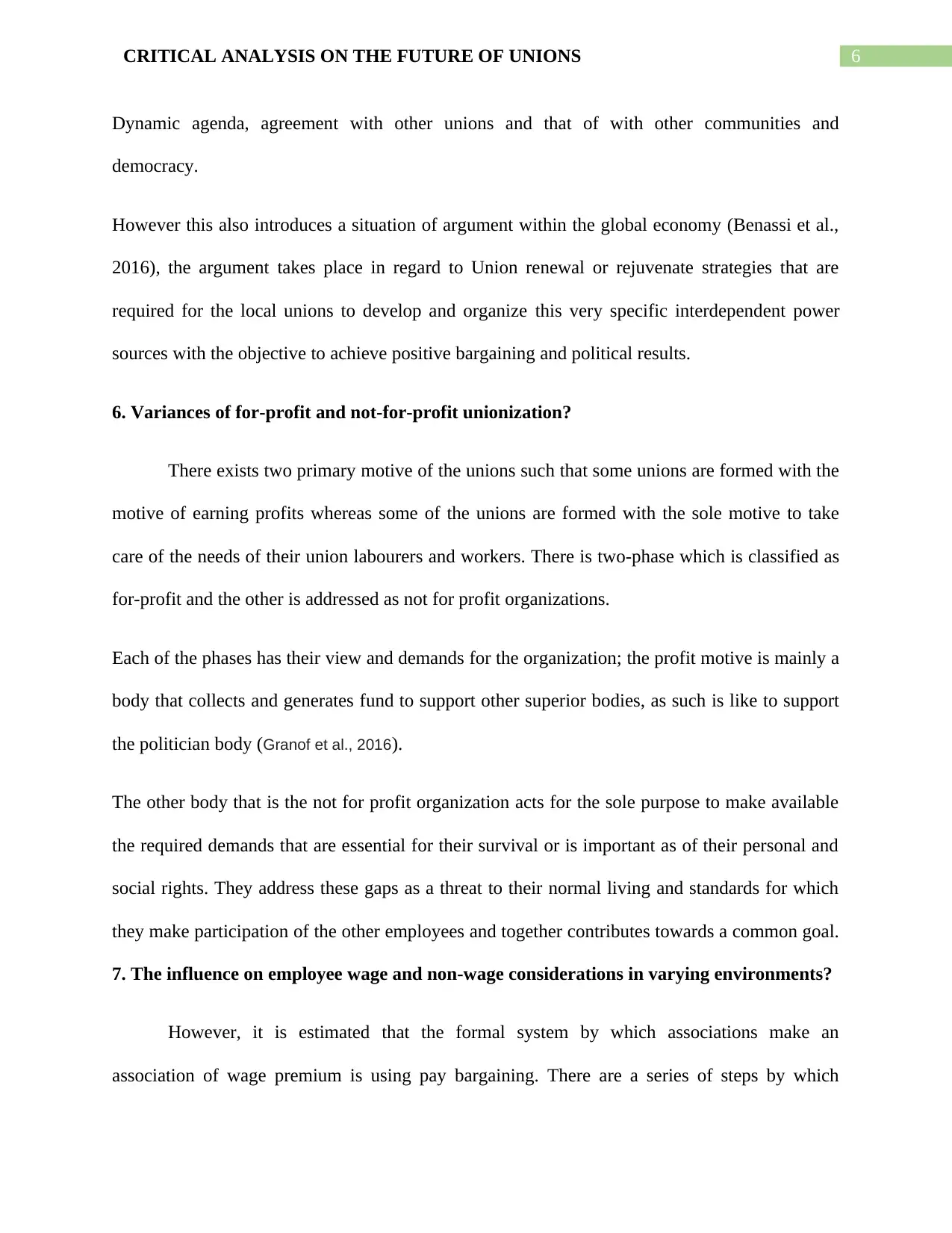
6CRITICAL ANALYSIS ON THE FUTURE OF UNIONS
Dynamic agenda, agreement with other unions and that of with other communities and
democracy.
However this also introduces a situation of argument within the global economy (Benassi et al.,
2016), the argument takes place in regard to Union renewal or rejuvenate strategies that are
required for the local unions to develop and organize this very specific interdependent power
sources with the objective to achieve positive bargaining and political results.
6. Variances of for-profit and not-for-profit unionization?
There exists two primary motive of the unions such that some unions are formed with the
motive of earning profits whereas some of the unions are formed with the sole motive to take
care of the needs of their union labourers and workers. There is two-phase which is classified as
for-profit and the other is addressed as not for profit organizations.
Each of the phases has their view and demands for the organization; the profit motive is mainly a
body that collects and generates fund to support other superior bodies, as such is like to support
the politician body (Granof et al., 2016).
The other body that is the not for profit organization acts for the sole purpose to make available
the required demands that are essential for their survival or is important as of their personal and
social rights. They address these gaps as a threat to their normal living and standards for which
they make participation of the other employees and together contributes towards a common goal.
7. The influence on employee wage and non-wage considerations in varying environments?
However, it is estimated that the formal system by which associations make an
association of wage premium is using pay bargaining. There are a series of steps by which
Dynamic agenda, agreement with other unions and that of with other communities and
democracy.
However this also introduces a situation of argument within the global economy (Benassi et al.,
2016), the argument takes place in regard to Union renewal or rejuvenate strategies that are
required for the local unions to develop and organize this very specific interdependent power
sources with the objective to achieve positive bargaining and political results.
6. Variances of for-profit and not-for-profit unionization?
There exists two primary motive of the unions such that some unions are formed with the
motive of earning profits whereas some of the unions are formed with the sole motive to take
care of the needs of their union labourers and workers. There is two-phase which is classified as
for-profit and the other is addressed as not for profit organizations.
Each of the phases has their view and demands for the organization; the profit motive is mainly a
body that collects and generates fund to support other superior bodies, as such is like to support
the politician body (Granof et al., 2016).
The other body that is the not for profit organization acts for the sole purpose to make available
the required demands that are essential for their survival or is important as of their personal and
social rights. They address these gaps as a threat to their normal living and standards for which
they make participation of the other employees and together contributes towards a common goal.
7. The influence on employee wage and non-wage considerations in varying environments?
However, it is estimated that the formal system by which associations make an
association of wage premium is using pay bargaining. There are a series of steps by which
Paraphrase This Document
Need a fresh take? Get an instant paraphrase of this document with our AI Paraphraser
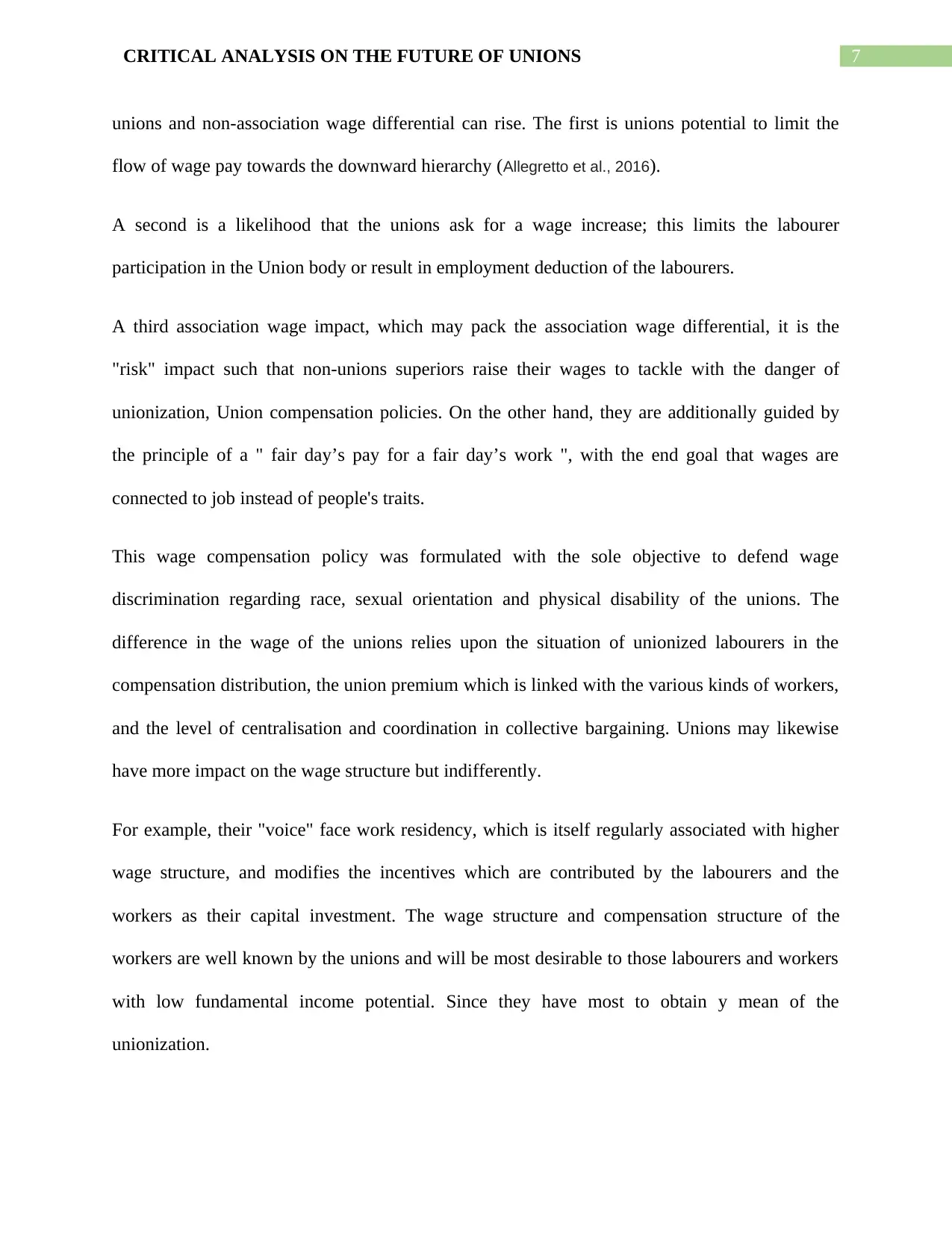
7CRITICAL ANALYSIS ON THE FUTURE OF UNIONS
unions and non-association wage differential can rise. The first is unions potential to limit the
flow of wage pay towards the downward hierarchy (Allegretto et al., 2016).
A second is a likelihood that the unions ask for a wage increase; this limits the labourer
participation in the Union body or result in employment deduction of the labourers.
A third association wage impact, which may pack the association wage differential, it is the
"risk" impact such that non-unions superiors raise their wages to tackle with the danger of
unionization, Union compensation policies. On the other hand, they are additionally guided by
the principle of a " fair day’s pay for a fair day’s work ", with the end goal that wages are
connected to job instead of people's traits.
This wage compensation policy was formulated with the sole objective to defend wage
discrimination regarding race, sexual orientation and physical disability of the unions. The
difference in the wage of the unions relies upon the situation of unionized labourers in the
compensation distribution, the union premium which is linked with the various kinds of workers,
and the level of centralisation and coordination in collective bargaining. Unions may likewise
have more impact on the wage structure but indifferently.
For example, their "voice" face work residency, which is itself regularly associated with higher
wage structure, and modifies the incentives which are contributed by the labourers and the
workers as their capital investment. The wage structure and compensation structure of the
workers are well known by the unions and will be most desirable to those labourers and workers
with low fundamental income potential. Since they have most to obtain y mean of the
unionization.
unions and non-association wage differential can rise. The first is unions potential to limit the
flow of wage pay towards the downward hierarchy (Allegretto et al., 2016).
A second is a likelihood that the unions ask for a wage increase; this limits the labourer
participation in the Union body or result in employment deduction of the labourers.
A third association wage impact, which may pack the association wage differential, it is the
"risk" impact such that non-unions superiors raise their wages to tackle with the danger of
unionization, Union compensation policies. On the other hand, they are additionally guided by
the principle of a " fair day’s pay for a fair day’s work ", with the end goal that wages are
connected to job instead of people's traits.
This wage compensation policy was formulated with the sole objective to defend wage
discrimination regarding race, sexual orientation and physical disability of the unions. The
difference in the wage of the unions relies upon the situation of unionized labourers in the
compensation distribution, the union premium which is linked with the various kinds of workers,
and the level of centralisation and coordination in collective bargaining. Unions may likewise
have more impact on the wage structure but indifferently.
For example, their "voice" face work residency, which is itself regularly associated with higher
wage structure, and modifies the incentives which are contributed by the labourers and the
workers as their capital investment. The wage structure and compensation structure of the
workers are well known by the unions and will be most desirable to those labourers and workers
with low fundamental income potential. Since they have most to obtain y mean of the
unionization.
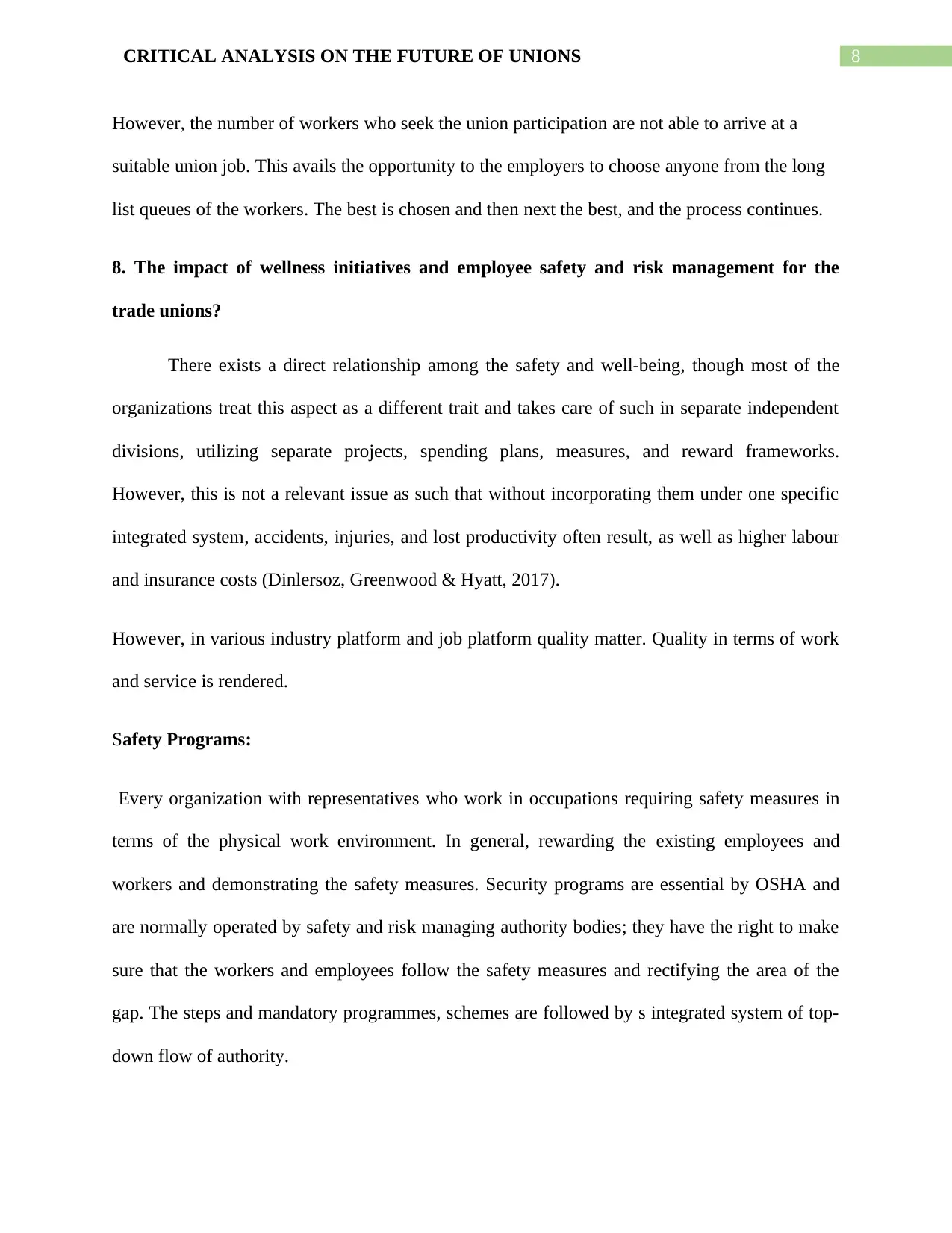
8CRITICAL ANALYSIS ON THE FUTURE OF UNIONS
However, the number of workers who seek the union participation are not able to arrive at a
suitable union job. This avails the opportunity to the employers to choose anyone from the long
list queues of the workers. The best is chosen and then next the best, and the process continues.
8. The impact of wellness initiatives and employee safety and risk management for the
trade unions?
There exists a direct relationship among the safety and well-being, though most of the
organizations treat this aspect as a different trait and takes care of such in separate independent
divisions, utilizing separate projects, spending plans, measures, and reward frameworks.
However, this is not a relevant issue as such that without incorporating them under one specific
integrated system, accidents, injuries, and lost productivity often result, as well as higher labour
and insurance costs (Dinlersoz, Greenwood & Hyatt, 2017).
However, in various industry platform and job platform quality matter. Quality in terms of work
and service is rendered.
Safety Programs:
Every organization with representatives who work in occupations requiring safety measures in
terms of the physical work environment. In general, rewarding the existing employees and
workers and demonstrating the safety measures. Security programs are essential by OSHA and
are normally operated by safety and risk managing authority bodies; they have the right to make
sure that the workers and employees follow the safety measures and rectifying the area of the
gap. The steps and mandatory programmes, schemes are followed by s integrated system of top-
down flow of authority.
However, the number of workers who seek the union participation are not able to arrive at a
suitable union job. This avails the opportunity to the employers to choose anyone from the long
list queues of the workers. The best is chosen and then next the best, and the process continues.
8. The impact of wellness initiatives and employee safety and risk management for the
trade unions?
There exists a direct relationship among the safety and well-being, though most of the
organizations treat this aspect as a different trait and takes care of such in separate independent
divisions, utilizing separate projects, spending plans, measures, and reward frameworks.
However, this is not a relevant issue as such that without incorporating them under one specific
integrated system, accidents, injuries, and lost productivity often result, as well as higher labour
and insurance costs (Dinlersoz, Greenwood & Hyatt, 2017).
However, in various industry platform and job platform quality matter. Quality in terms of work
and service is rendered.
Safety Programs:
Every organization with representatives who work in occupations requiring safety measures in
terms of the physical work environment. In general, rewarding the existing employees and
workers and demonstrating the safety measures. Security programs are essential by OSHA and
are normally operated by safety and risk managing authority bodies; they have the right to make
sure that the workers and employees follow the safety measures and rectifying the area of the
gap. The steps and mandatory programmes, schemes are followed by s integrated system of top-
down flow of authority.
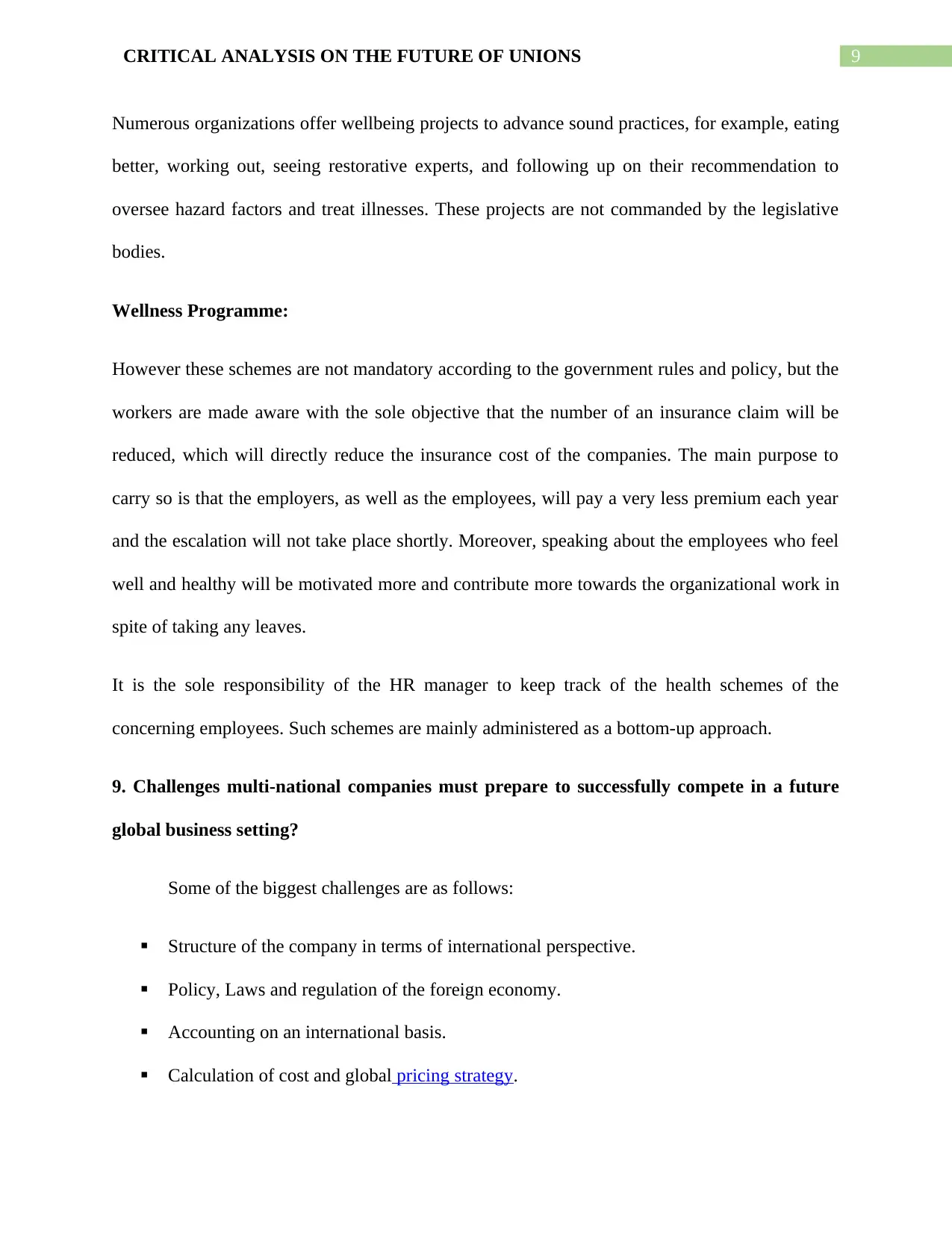
9CRITICAL ANALYSIS ON THE FUTURE OF UNIONS
Numerous organizations offer wellbeing projects to advance sound practices, for example, eating
better, working out, seeing restorative experts, and following up on their recommendation to
oversee hazard factors and treat illnesses. These projects are not commanded by the legislative
bodies.
Wellness Programme:
However these schemes are not mandatory according to the government rules and policy, but the
workers are made aware with the sole objective that the number of an insurance claim will be
reduced, which will directly reduce the insurance cost of the companies. The main purpose to
carry so is that the employers, as well as the employees, will pay a very less premium each year
and the escalation will not take place shortly. Moreover, speaking about the employees who feel
well and healthy will be motivated more and contribute more towards the organizational work in
spite of taking any leaves.
It is the sole responsibility of the HR manager to keep track of the health schemes of the
concerning employees. Such schemes are mainly administered as a bottom-up approach.
9. Challenges multi-national companies must prepare to successfully compete in a future
global business setting?
Some of the biggest challenges are as follows:
Structure of the company in terms of international perspective.
Policy, Laws and regulation of the foreign economy.
Accounting on an international basis.
Calculation of cost and global pricing strategy.
Numerous organizations offer wellbeing projects to advance sound practices, for example, eating
better, working out, seeing restorative experts, and following up on their recommendation to
oversee hazard factors and treat illnesses. These projects are not commanded by the legislative
bodies.
Wellness Programme:
However these schemes are not mandatory according to the government rules and policy, but the
workers are made aware with the sole objective that the number of an insurance claim will be
reduced, which will directly reduce the insurance cost of the companies. The main purpose to
carry so is that the employers, as well as the employees, will pay a very less premium each year
and the escalation will not take place shortly. Moreover, speaking about the employees who feel
well and healthy will be motivated more and contribute more towards the organizational work in
spite of taking any leaves.
It is the sole responsibility of the HR manager to keep track of the health schemes of the
concerning employees. Such schemes are mainly administered as a bottom-up approach.
9. Challenges multi-national companies must prepare to successfully compete in a future
global business setting?
Some of the biggest challenges are as follows:
Structure of the company in terms of international perspective.
Policy, Laws and regulation of the foreign economy.
Accounting on an international basis.
Calculation of cost and global pricing strategy.
Secure Best Marks with AI Grader
Need help grading? Try our AI Grader for instant feedback on your assignments.
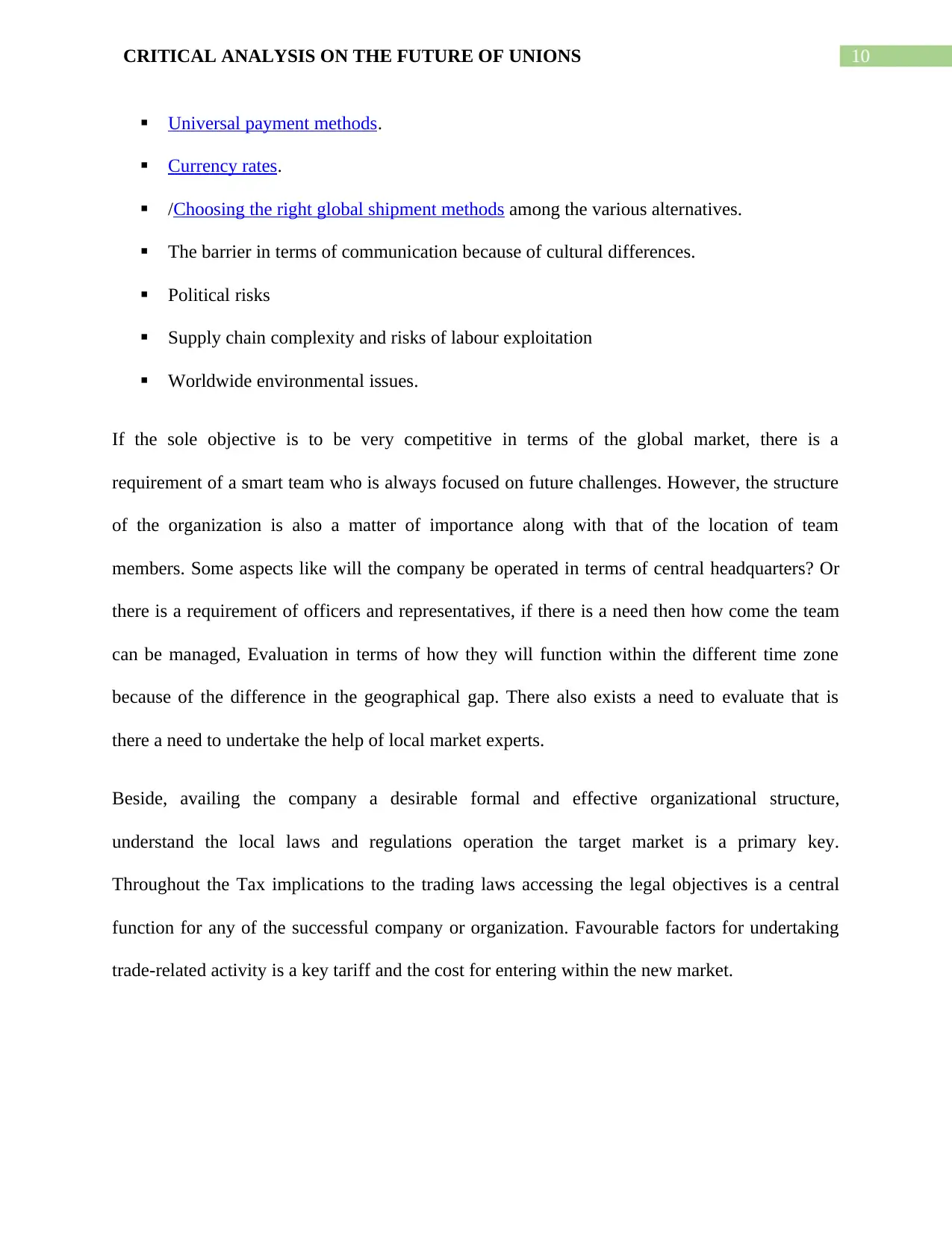
10CRITICAL ANALYSIS ON THE FUTURE OF UNIONS
Universal payment methods.
Currency rates.
/Choosing the right global shipment methods among the various alternatives.
The barrier in terms of communication because of cultural differences.
Political risks
Supply chain complexity and risks of labour exploitation
Worldwide environmental issues.
If the sole objective is to be very competitive in terms of the global market, there is a
requirement of a smart team who is always focused on future challenges. However, the structure
of the organization is also a matter of importance along with that of the location of team
members. Some aspects like will the company be operated in terms of central headquarters? Or
there is a requirement of officers and representatives, if there is a need then how come the team
can be managed, Evaluation in terms of how they will function within the different time zone
because of the difference in the geographical gap. There also exists a need to evaluate that is
there a need to undertake the help of local market experts.
Beside, availing the company a desirable formal and effective organizational structure,
understand the local laws and regulations operation the target market is a primary key.
Throughout the Tax implications to the trading laws accessing the legal objectives is a central
function for any of the successful company or organization. Favourable factors for undertaking
trade-related activity is a key tariff and the cost for entering within the new market.
Universal payment methods.
Currency rates.
/Choosing the right global shipment methods among the various alternatives.
The barrier in terms of communication because of cultural differences.
Political risks
Supply chain complexity and risks of labour exploitation
Worldwide environmental issues.
If the sole objective is to be very competitive in terms of the global market, there is a
requirement of a smart team who is always focused on future challenges. However, the structure
of the organization is also a matter of importance along with that of the location of team
members. Some aspects like will the company be operated in terms of central headquarters? Or
there is a requirement of officers and representatives, if there is a need then how come the team
can be managed, Evaluation in terms of how they will function within the different time zone
because of the difference in the geographical gap. There also exists a need to evaluate that is
there a need to undertake the help of local market experts.
Beside, availing the company a desirable formal and effective organizational structure,
understand the local laws and regulations operation the target market is a primary key.
Throughout the Tax implications to the trading laws accessing the legal objectives is a central
function for any of the successful company or organization. Favourable factors for undertaking
trade-related activity is a key tariff and the cost for entering within the new market.
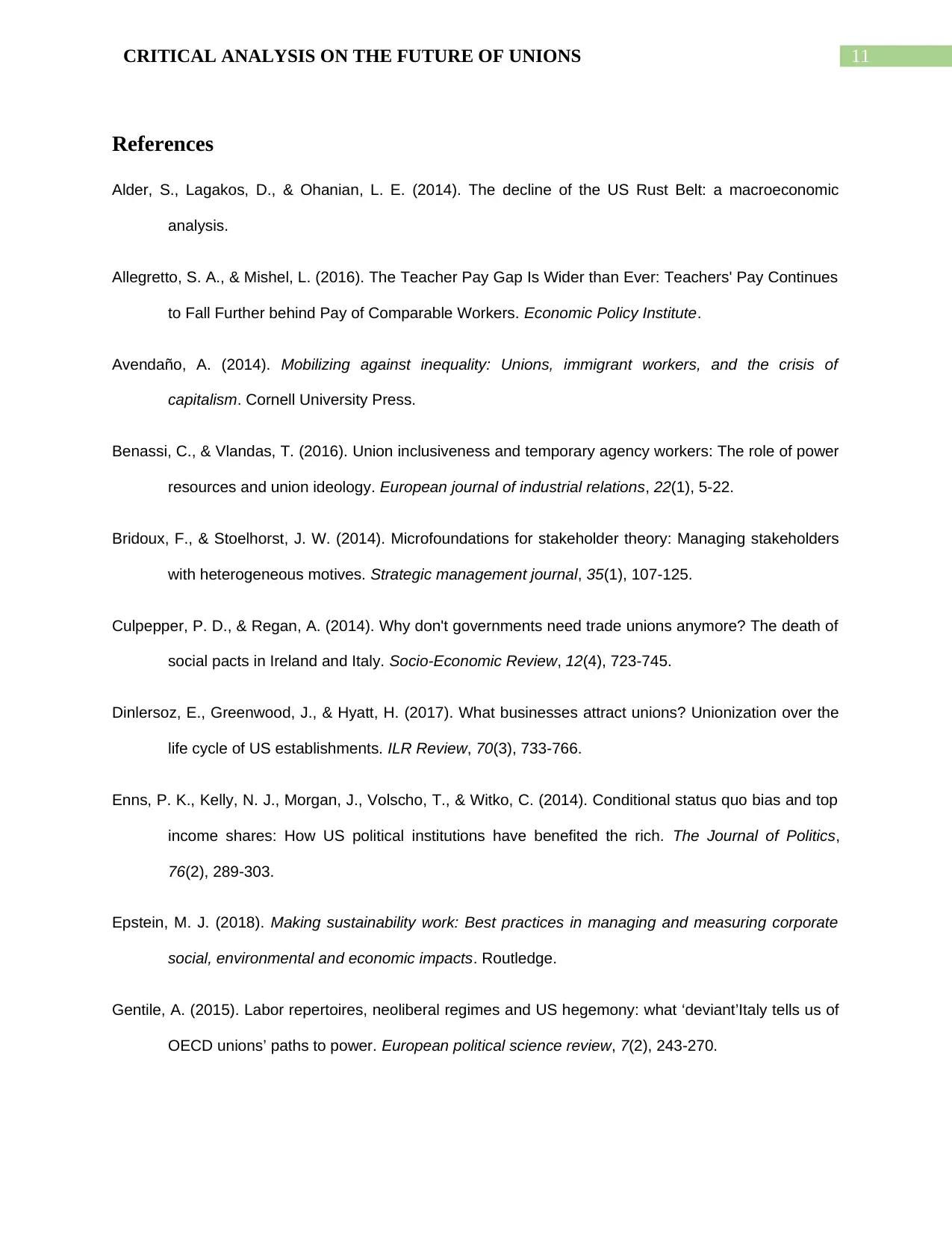
11CRITICAL ANALYSIS ON THE FUTURE OF UNIONS
References
Alder, S., Lagakos, D., & Ohanian, L. E. (2014). The decline of the US Rust Belt: a macroeconomic
analysis.
Allegretto, S. A., & Mishel, L. (2016). The Teacher Pay Gap Is Wider than Ever: Teachers' Pay Continues
to Fall Further behind Pay of Comparable Workers. Economic Policy Institute.
Avendaño, A. (2014). Mobilizing against inequality: Unions, immigrant workers, and the crisis of
capitalism. Cornell University Press.
Benassi, C., & Vlandas, T. (2016). Union inclusiveness and temporary agency workers: The role of power
resources and union ideology. European journal of industrial relations, 22(1), 5-22.
Bridoux, F., & Stoelhorst, J. W. (2014). Microfoundations for stakeholder theory: Managing stakeholders
with heterogeneous motives. Strategic management journal, 35(1), 107-125.
Culpepper, P. D., & Regan, A. (2014). Why don't governments need trade unions anymore? The death of
social pacts in Ireland and Italy. Socio-Economic Review, 12(4), 723-745.
Dinlersoz, E., Greenwood, J., & Hyatt, H. (2017). What businesses attract unions? Unionization over the
life cycle of US establishments. ILR Review, 70(3), 733-766.
Enns, P. K., Kelly, N. J., Morgan, J., Volscho, T., & Witko, C. (2014). Conditional status quo bias and top
income shares: How US political institutions have benefited the rich. The Journal of Politics,
76(2), 289-303.
Epstein, M. J. (2018). Making sustainability work: Best practices in managing and measuring corporate
social, environmental and economic impacts. Routledge.
Gentile, A. (2015). Labor repertoires, neoliberal regimes and US hegemony: what ‘deviant’Italy tells us of
OECD unions’ paths to power. European political science review, 7(2), 243-270.
References
Alder, S., Lagakos, D., & Ohanian, L. E. (2014). The decline of the US Rust Belt: a macroeconomic
analysis.
Allegretto, S. A., & Mishel, L. (2016). The Teacher Pay Gap Is Wider than Ever: Teachers' Pay Continues
to Fall Further behind Pay of Comparable Workers. Economic Policy Institute.
Avendaño, A. (2014). Mobilizing against inequality: Unions, immigrant workers, and the crisis of
capitalism. Cornell University Press.
Benassi, C., & Vlandas, T. (2016). Union inclusiveness and temporary agency workers: The role of power
resources and union ideology. European journal of industrial relations, 22(1), 5-22.
Bridoux, F., & Stoelhorst, J. W. (2014). Microfoundations for stakeholder theory: Managing stakeholders
with heterogeneous motives. Strategic management journal, 35(1), 107-125.
Culpepper, P. D., & Regan, A. (2014). Why don't governments need trade unions anymore? The death of
social pacts in Ireland and Italy. Socio-Economic Review, 12(4), 723-745.
Dinlersoz, E., Greenwood, J., & Hyatt, H. (2017). What businesses attract unions? Unionization over the
life cycle of US establishments. ILR Review, 70(3), 733-766.
Enns, P. K., Kelly, N. J., Morgan, J., Volscho, T., & Witko, C. (2014). Conditional status quo bias and top
income shares: How US political institutions have benefited the rich. The Journal of Politics,
76(2), 289-303.
Epstein, M. J. (2018). Making sustainability work: Best practices in managing and measuring corporate
social, environmental and economic impacts. Routledge.
Gentile, A. (2015). Labor repertoires, neoliberal regimes and US hegemony: what ‘deviant’Italy tells us of
OECD unions’ paths to power. European political science review, 7(2), 243-270.
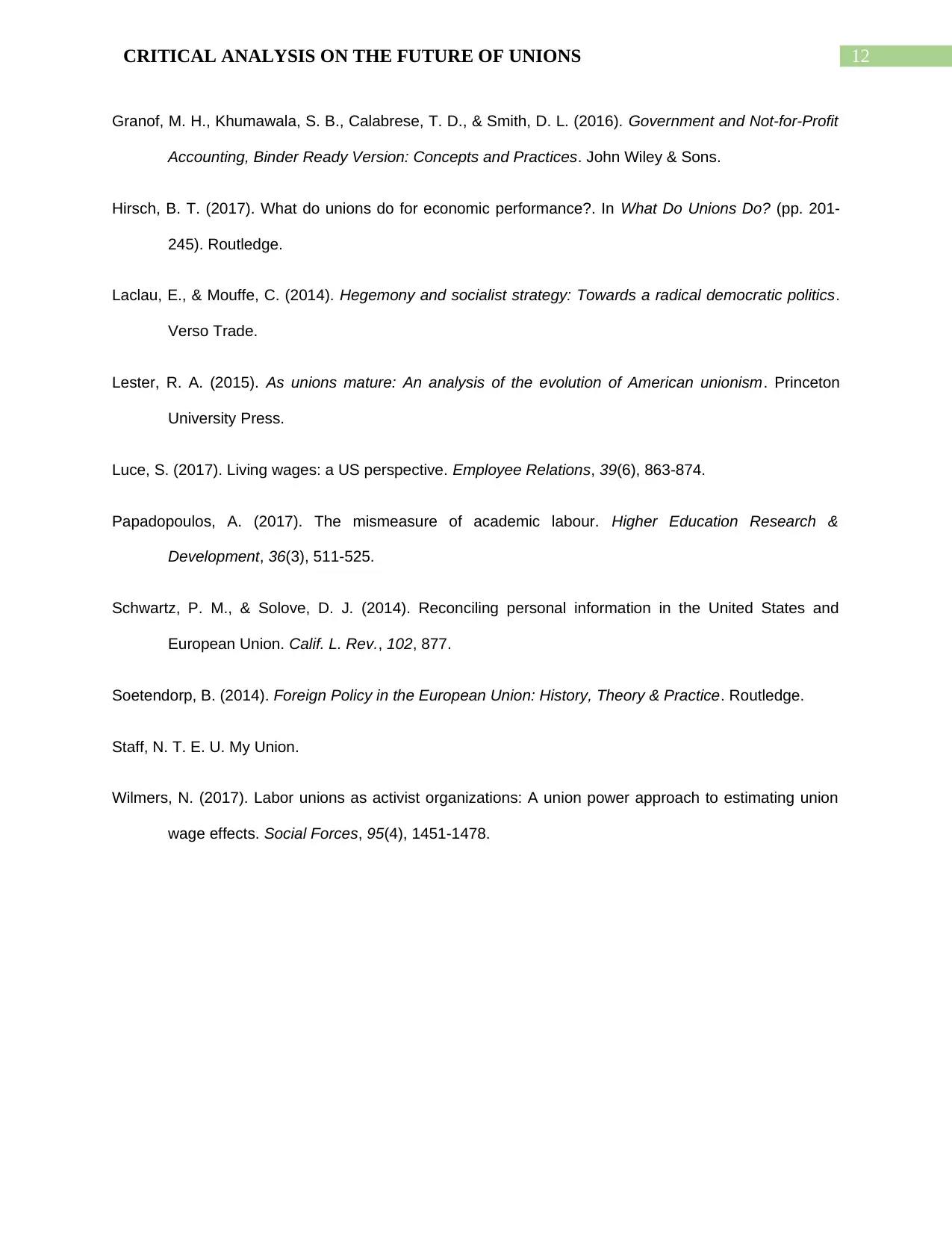
12CRITICAL ANALYSIS ON THE FUTURE OF UNIONS
Granof, M. H., Khumawala, S. B., Calabrese, T. D., & Smith, D. L. (2016). Government and Not-for-Profit
Accounting, Binder Ready Version: Concepts and Practices. John Wiley & Sons.
Hirsch, B. T. (2017). What do unions do for economic performance?. In What Do Unions Do? (pp. 201-
245). Routledge.
Laclau, E., & Mouffe, C. (2014). Hegemony and socialist strategy: Towards a radical democratic politics.
Verso Trade.
Lester, R. A. (2015). As unions mature: An analysis of the evolution of American unionism. Princeton
University Press.
Luce, S. (2017). Living wages: a US perspective. Employee Relations, 39(6), 863-874.
Papadopoulos, A. (2017). The mismeasure of academic labour. Higher Education Research &
Development, 36(3), 511-525.
Schwartz, P. M., & Solove, D. J. (2014). Reconciling personal information in the United States and
European Union. Calif. L. Rev., 102, 877.
Soetendorp, B. (2014). Foreign Policy in the European Union: History, Theory & Practice. Routledge.
Staff, N. T. E. U. My Union.
Wilmers, N. (2017). Labor unions as activist organizations: A union power approach to estimating union
wage effects. Social Forces, 95(4), 1451-1478.
Granof, M. H., Khumawala, S. B., Calabrese, T. D., & Smith, D. L. (2016). Government and Not-for-Profit
Accounting, Binder Ready Version: Concepts and Practices. John Wiley & Sons.
Hirsch, B. T. (2017). What do unions do for economic performance?. In What Do Unions Do? (pp. 201-
245). Routledge.
Laclau, E., & Mouffe, C. (2014). Hegemony and socialist strategy: Towards a radical democratic politics.
Verso Trade.
Lester, R. A. (2015). As unions mature: An analysis of the evolution of American unionism. Princeton
University Press.
Luce, S. (2017). Living wages: a US perspective. Employee Relations, 39(6), 863-874.
Papadopoulos, A. (2017). The mismeasure of academic labour. Higher Education Research &
Development, 36(3), 511-525.
Schwartz, P. M., & Solove, D. J. (2014). Reconciling personal information in the United States and
European Union. Calif. L. Rev., 102, 877.
Soetendorp, B. (2014). Foreign Policy in the European Union: History, Theory & Practice. Routledge.
Staff, N. T. E. U. My Union.
Wilmers, N. (2017). Labor unions as activist organizations: A union power approach to estimating union
wage effects. Social Forces, 95(4), 1451-1478.
1 out of 13
Related Documents
Your All-in-One AI-Powered Toolkit for Academic Success.
+13062052269
info@desklib.com
Available 24*7 on WhatsApp / Email
![[object Object]](/_next/static/media/star-bottom.7253800d.svg)
Unlock your academic potential
© 2024 | Zucol Services PVT LTD | All rights reserved.





